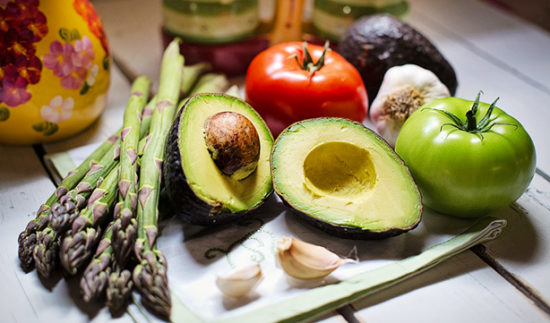Nutritional Value: Win with nature’s superfoods
A diet chock full of fruits and vegetables doesn’t guarantee a person will live forever, or even that they won’t succumb to the flu this season. As numerous studies consistently reveal, however, filling up on nature’s health-promoting, disease-fighting power foods is one of the best avenues to follow for those who desire to live long and well.
 Fruits and vegetables are naturally rich in such health-promoting nutrients as fiber, folate, potassium, vitamin A, phytonutrients (natural plant chemicals that appear to have disease-fighting properties) and anti-aging antioxidants, such as vitamin C. They also are low in disease-promoting substances such as salt, saturated fat and cancer-promoting substances such as heterocyclic amines (found in processed and smoked meats as well as any meat cooked at high temperatures over an open flame). To top it off, there is little risk of adding unwanted pounds while indulging in naturally low-calorie, wholesome fruits and vegetables.
Fruits and vegetables are naturally rich in such health-promoting nutrients as fiber, folate, potassium, vitamin A, phytonutrients (natural plant chemicals that appear to have disease-fighting properties) and anti-aging antioxidants, such as vitamin C. They also are low in disease-promoting substances such as salt, saturated fat and cancer-promoting substances such as heterocyclic amines (found in processed and smoked meats as well as any meat cooked at high temperatures over an open flame). To top it off, there is little risk of adding unwanted pounds while indulging in naturally low-calorie, wholesome fruits and vegetables.
The bottom line is that everyone would be healthier eating more fruit, especially more vegetables. When it comes to fruits and vegetables, nutrition experts like to say that eating some is better than eating none, and eating more is definitely better than eating some.
The following simple strategies can be used by those who want to boost their daily fruit and veggie intake.
1. Eat a daily rainbow of fruits and vegetables.
Think color. Fruits and vegetables that are colorful, as in red, orange, deep yellow, green, and deep blue or purple, qualify for superfood status. These options are guaranteed to deliver hefty doses of vitamins A and C, as well as carotenoids and other health-enhancing phytonutrients like anthocyanins, lycopene and lutein. Aim for at least one serving daily from each “stripe of the rainbow.”
- Red: tomatoes, pink grapefruit, red bell peppers, red apples, red pears, strawberries, raspberries, watermelon, radishes, beets.
- Orange/deep yellow: winter squash, carrots, sweet potatoes, sweet corn, cantaloupe, mango, oranges, papaya, apricots, pumpkin, yellow grapefruit, oranges, nectarines, peaches.
- Green: broccoli, spinach, kale, collard greens, bok choy, Brussels sprouts, cabbage, kiwi fruit, bell peppers, peas, avocadoes, green apples, green pears.
- Deep blue/purple: eggplant, blueberries, blackberries, red/purple cabbage, cherries, plums, prunes, figs, raisins, dates.
2. Eat the real thing.
Don’t waste time on “pretenders,” as in juices or beverages made with less than 100 percent fruit juice, high-calorie fruit smoothies with lots of extras and pale green side salads. Rationalizations about fulfilling the day’s quota by eating corn or sweet potato chips, strawberry Pop-Tarts and carrot cake are even emptier promises. Supplements can help to fill in nutritional gaps, but they don’t supply fiber or yet-to-be discovered phytonutrients, nor do they satisfy hunger pains like real fruits and vegetables do.
A serving is equivalent to one medium piece of fruit (apple or orange), 6 ounces of 100 percent fruit or vegetable juice, 1 cup leafy greens, 1/2 cup of cut-up raw or cooked fruit or vegetable, or 1/4 cup of dried fruit. Aim for a minimum of five servings daily.
For people who find this too complicated, just remember to fill half the plate with fruits and vegetables at every meal or snack occasion.
Contrary to public opinion, canned and frozen varieties are just as nutritious (choose low or no sodium varieties, and to limit empty calories avoid fruit canned in heavy syrup). These can save busy people valuable time.
3. Start early in the day.
Until it’s a well established-habit, most people will have to work at eating at least five servings of fruits and vegetables daily. Waiting until dinner time makes it nearly impossible to accomplish this goal, so experts recommend starting the day with a breakfast that includes a glass of 100 percent fruit or vegetable juice as well as some fruit and building from there.
Keep easy-to-grab-and-eat veggies on hand, such as baby carrots, sugar snap peas, cherry tomatoes and broccoli spears. Time-saving options include prepackaged (prewashed) salad greens and raw or cooked veggies purchased directly from a salad bar. Add flavor and interest by dipping in low-fat salad dressing. Also, keep small packages of dried fruit on hand for healthy snacking. Go beyond raisins and try dried dates, figs, plums, apricots and cherries.
Top green salads with fruit. Tasty options include kiwi, mandarin oranges, pineapple chunks and nectarines. You can even microwave a sweet potato for a quick, filling snack or lunch while including a mixed green salad or vegetable soup.
When not brown-bagging it, opt for fresh vegetable wraps, vegetable pizza and veggie-based pasta dishes without cream sauces. Puree canned or frozen fruit, like berries, peaches or apricots, and keep these on hand to spoon over vanilla yogurt, pudding or low-fat ice cream.
For more recommendations, visit www.fruitsandveggiesmorematters.org.
Nutritional Value is a column that focuses on athlete health and wellness. It appears regularly in Coach & Athletic Director magazine.





